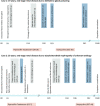Unexpected Mycoplasma hominis infection in two renal transplant recipients traced back to the same donor by whole-genome sequencing
- PMID: 33367958
- PMCID: PMC8084823
- DOI: 10.1007/s10096-020-04116-y
Unexpected Mycoplasma hominis infection in two renal transplant recipients traced back to the same donor by whole-genome sequencing
Abstract
Mycoplasma hominis is a common colonizer of the lower genitourinary tract. Although its clinical relevance for causing urogenital infections in immunocompetent individuals is controversial, this bacterium has been involved in severe invasive infections in allograft recipients. In this report, we describe two cases of M. hominis infection in two young renal transplant recipients within the first month post-transplant. Although at first no epidemiological link between the two cases had been suspected, whole-genome sequencing (WGS) analysis showed that both isolates were identical, highly suggestive of an origin with the common organ donor.
Keywords: Mycoplasma hominis; Renal transplant; Typing; Whole-genome sequencing (WGS).
Conflict of interest statement
Not applicable.
Figures



Similar articles
-
Donor-Derived Mycoplasma hominis and an Apparent Cluster of M. hominis Cases in Solid Organ Transplant Recipients.Clin Infect Dis. 2017 Oct 16;65(9):1504-1508. doi: 10.1093/cid/cix601. Clin Infect Dis. 2017. PMID: 29048510
-
Mycoplasma hominis infections in solid organ transplant recipients: Clinical characteristics, treatment outcomes, and comparison of phenotypic and genotypic susceptibility profiles.Transpl Infect Dis. 2022 Jun;24(3):e13822. doi: 10.1111/tid.13822. Epub 2022 Mar 16. Transpl Infect Dis. 2022. PMID: 35253965
-
Cardiothoracic Transplant Recipient Mycoplasma hominis: An Uncommon Infection with Probable Donor Transmission.EBioMedicine. 2017 May;19:84-90. doi: 10.1016/j.ebiom.2017.04.026. Epub 2017 Apr 19. EBioMedicine. 2017. PMID: 28438507 Free PMC article.
-
Mycoplasma hominis bursitis in a simultaneous pancreas-kidney transplant recipient: case report and literature review.Transpl Infect Dis. 2020 Dec;22(6):e13392. doi: 10.1111/tid.13392. Epub 2020 Jul 24. Transpl Infect Dis. 2020. PMID: 32603519 Review.
-
Ureaplasma and Mycoplasma in kidney allograft recipients-A case series and review of the literature.Transpl Infect Dis. 2018 Oct;20(5):e12937. doi: 10.1111/tid.12937. Epub 2018 Jun 15. Transpl Infect Dis. 2018. PMID: 29856498 Review.
Cited by
-
Identification of sacrococcygeal and pelvic abscesses infected with invasive Mycoplasma hominis by MALDI-TOF MS.J Clin Lab Anal. 2022 Apr;36(4):e24329. doi: 10.1002/jcla.24329. Epub 2022 Mar 13. J Clin Lab Anal. 2022. PMID: 35285086 Free PMC article.
-
NGSocomial Infections: High-Resolution Views of Hospital-Acquired Infections Through Genomic Epidemiology.J Pediatric Infect Dis Soc. 2021 Dec 24;10(Supplement_4):S88-S95. doi: 10.1093/jpids/piab074. J Pediatric Infect Dis Soc. 2021. PMID: 34951469 Free PMC article. Review.
-
Mycoplasma and Ureaplasma Donor-Derived Infection and Hyperammonemia Syndrome in 4 Solid Organ Transplant Recipients From a Single Donor.Open Forum Infect Dis. 2023 May 19;10(6):ofad263. doi: 10.1093/ofid/ofad263. eCollection 2023 Jun. Open Forum Infect Dis. 2023. PMID: 37323424 Free PMC article.
References
-
- Horner P, Donders G, Cusini M, Gomberg M, Jensen JS, Unemo M. Should we be testing for urogenital Mycoplasma hominis, Ureaplasma parvum and Ureaplasma urealyticum in men and women?-a position statement from the European STI Guidelines Editorial Board. J Eur Acad Dermatol Venereol. 2018;32(11):1845–1851. doi: 10.1111/jdv.15146. - DOI - PubMed
Publication types
MeSH terms
Substances
LinkOut - more resources
Full Text Sources
Medical

